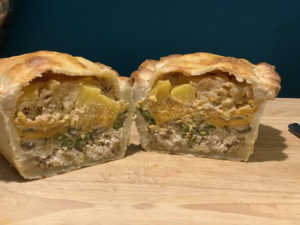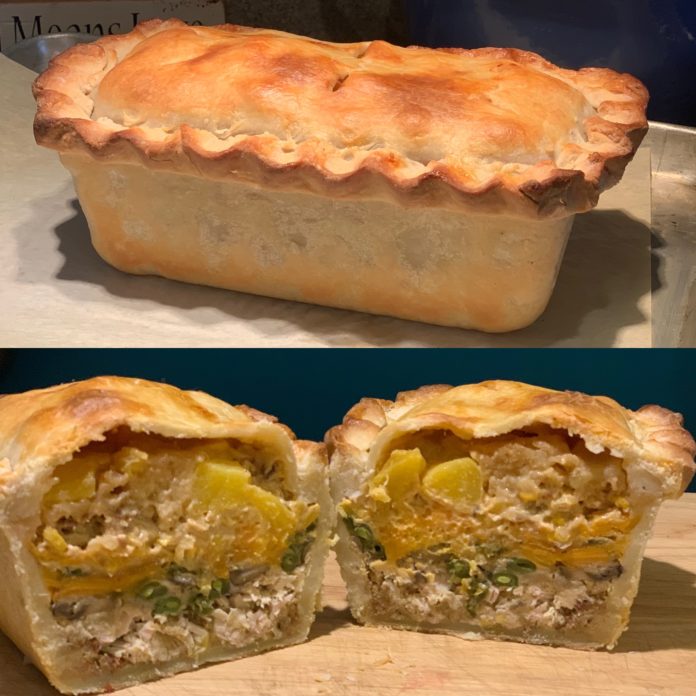Stephen Sondheim died last week.
He had Thanksgiving dinner with friends and died on Friday, unexpectedly it seems.
Looking back through my texts, I heard about his death around six on Friday, because that is when I wrote a friend with whom I share a love of Sondheim and his songs. I was in the kitchen making a Thanksgiving Leftover Pie, something new to me, but now something that will become a part of all our Thanksgivings going forward. (My version is at the end of this post.)
This morning, I read the tribute to Sondheim in The Atlantic and I was caught by two paragraphs in particular:
I’m sure Sondheim knew better, though. He never believed in simple happy endings, but he knew exactly how to take advantage of his audience’s yearning for them. In Into the Woods, for which he wrote the music and lyrics, the characters end Act I singing the jaunty “Ever After,” blissfully unsuspecting of the complications that await them in the second act.
and
Before Company, Sondheim said in the 2004 documentary, musicals “would always lead to the so-called happy ending. We were saying something ambiguous, which is ‘Actually, there are no endings’; it keeps going on is what, really, Company’s about.”
Even though neither Sondheim nor the writer of the piece used the word, I thought, “They’re talking about leftovers.”
Leftovers are the things you make into a meal after the meal. They are what you do after the happy ending, if you will. After the big gathering around the table we have all anticipated, after we have stuffed ourselves and then had pie, after we have napped and walked and talked, we come back to the fridge and pull out the leftovers to see what we can make of them, whether it’s a sandwich, a soup, or a pie.
Leftovers make pretty good metaphors as well. If Sondheim is right–and I think he is–life gets lived in the ever afters, in the stuff that happens after the endings. In the leftovers. The longer we live, the more bits and pieces we are left with to see what we can make of them. Wounds can become weapons or windows. Memories season our days in ways both sweet and savory, I suppose, though some we have to choose to no longer digest. The tables to which we return, whether the annual gatherings for holidays or the daily seats we take for breakfast and dinner, are never completely absent of what has been shared there already.
Life offers none of us a clean slate. We’re all dealing with leftover lives.
That’s good news, I think. At least that’s what I learned (again) from the Thanksgiving Pie. After we cut it open and ate it, I said, “I think I would make the whole meal again just so I could wait a day and make this.” Everything in the pie had already been on the table. All of the dishes are things i have made over and over. There were no surprises. And yet, when I layered them inside the pastry and baked them into a loaf pie that looked worthy of being cut open on The Great British Baking Show, it felt (and tasted) like I had done a new thing. And I had–with the leftovers.
One of the ways I am approaching Advent this year is thinking about it as a leftover story, not only as I read the story again in scripture, but also as I think about how we retell it in our time. Jesus was born in the middle of a colonized nation, as a part of an oppressed people, and to a family that was confused and frightened by much of what happened. No one was expecting an ever after, much less a happy one. And Jesus’ birth did not bring one. Nothing was solved in Bethlehem. The angels may have sung, but it was not a big finale. Love came down at Christmas and God has been making stuff out of the leftovers ever since.
Enjoy the recipe. Fill it with whatever you have.
Peace,
Milton
Thanksgiving Leftover Pie
Ingredients
For the hot water pastry:
4 cups all purpose flour
1 teaspoon salt
1 cup water
8 tablespoons unsalted butter (1 stick) or lard
For the filling:
dressing or stuffing
turkey, diced
vegetables
gravy
sweet potatoes or mashed potatoes
For the egg wash:
1 large egg yolk beaten with 1 tablespoon water
For the pastry:
Whisk together the flour and salt in a large bowl and make a well in the center.
Bring the water and fat to a boil in a large saucepan; stir as you go to melt the fat.
Pour the liquid into the well in the flour mixture and stir it until everything is evenly moistened and cool enough to handle comfortably. Once the liquid is incorporated, I use my hands to mix the dough. Turn the dough out onto a lightly floured surface and knead it a few times. Cut off a third of the dough for the top and set it aside to keep warm. (I wrap mine in a towel.)
Roll the remaining dough into a 16” long and 12” wide rectangle. Press it into a 9” x 5” loaf pan so the edges hang over the sides about a half an inch. Press the bottom down a bit to make sure it fits.
To assemble the pie:
Preheat the oven to 375°F. Spread all the filling ingredients (except the cranberry sauce) on top of one another in even layers. Each layer will be about 1/2 inch thick. I put the dressing on the bottom almost like a bed for the other stuff. I also finished with the sweet potatoes to create a kind of lid. Fill the pan full, so it even domes a little.
Roll the remaining dough into rectangle that fits the loaf pan. Place on top and then fold the overhanging edges of the bottom crust over and crimp the dough to seal it. Cut several slits in the top to vent it.
Brush the top of the pie with the egg wash. Place on a parchment-lined baking sheet and bake for 45 to 55 minutes, until you see liquid bubbling through the vents and the top crust is golden brown. Remove the pie from the oven and let it rest for at least fifteen minutes before slicing. It tastes good hot, at room temperature, and cold from the fridge.

A fantastic metaphor, and a helpful perspective on leftover memories and experiences. Thank you!
This spoke to me deeply in a time of grieving. May all the leftovers become a beautiful pie! Thanks Milton